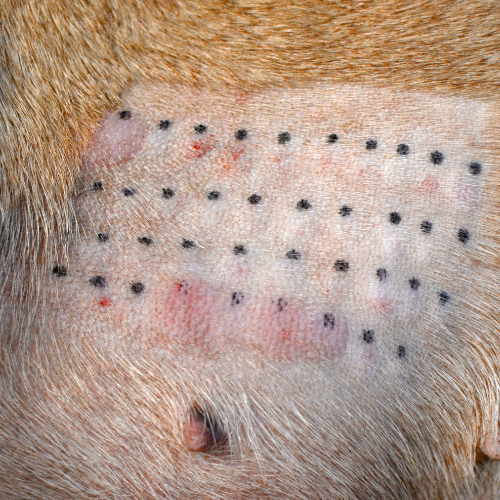Atopic dermatitis
What is atopy?
The immune system plays a crucial role in keeping harmful intruders under control, such as bacteria and viruses that can otherwise cause serious disease. Atopy is a type of allergy where the immune system has an inappropriate overreaction to common non-harmful allergens, treating them as dangerous germs. If you have allergies to pollen, asthma, hay fever, or a food allergy (e.g. nuts, shellfish, etc.), it is likely that atopy is an underlying cause.
On top of having a stronger-than-normal reaction to common allergens, pets with atopy often have a skin barrier defect which allows for environmental stimuli to penetrate deeper into the skin. This will present as itchy skin or atopic dermatitis (skin irritation due to atopy) – think of itchy eczema skin in human beings!
The severity of atopic dermatitis is believed to be dictated by:
- Individual genetics
- Degree of skin barrier defect
- Environment and exposure to allergens

How is atopic dermatitis diagnosed?
Unfortunately, there is no specific test to diagnose atopic dermatitis. A clinical diagnosis is achieved by ruling out or controlling other similar skin disorders like flea bite allergy, contact of environmental allergies, and food allergies. Frustratingly, these allergies are not exclusive to each other and your pet can have multiple types of allergies at the same time!

My pet has atopic dermatitis – what are they allergic to?
Just like people with allergies, our pets can be allergic to anything – pollen, dust, mites, mould and dander are some of the more common allergens. Interestingly, animals can also be allergic to human dander, and dogs can be allergic to cats and vice versa! Animals can also be allergic to their normal population of skin bacteria and fungi. Unfortunately, the skin can only react in limited ways (e.g itchiness, inflammation, redness, etc.) so an atopic reaction to different allergens, such as pollen versus dust, would often have the same clinical presentation. This means there’s no way of telling the allergens are just by looking at your pet!
One of the methods to identify what allergens are triggering your pet’s atopic dermatitis is through intradermal allergy testing. This is usually performed by a veterinary dermatologist and involves clipping a patch of fur on your pet’s side and injecting the skin with small amounts of different individual allergens. A positive reaction is seens as a swelling or lump over the injection site. Some veterinary dermatologists will also have a serum allergy blood test performed to gain a more accurate allergy profile of your pet.
How is atopic dermatitis managed or treated?
Atopic dermatitis is a complex disease with many different contributing factors to the overall severity, so management and treatment must be individualised to your pet’s specific needs – it is not a one-size-fits-all approach! The most effective management and treatment of atopic dermatitis is achieved through multimodal therapy.
- Topical skin barrier management
Skin is considered to be the body’s first host defence mechanism against allergens and microorganisms so maintaining this healthy barrier is very important. To start, ensure your pet is always up-to-date with their parasite preventatives (e.g. fleas, mites, ticks). There are several topical products that can also be used to nourish the skin barrier – think of moisturising creams and gentle body washes for people with eczema! A couple of products we often recommend are PAW Nutriderm Replenishing Shampoo and PAW Nutriderm Conditioner.
- Itch control medication
If you have ever had eczema or a mosquito bite, you will be very familiar with the self-perpetuating itch cycle – the more you scratch, the itchier it gets! It is important to manage itch as the self-trauma from your pet’s scratching can rapidly result in marked skin inflammation, hair loss and development of secondary infections. A number of itch control medications that can be utilised include:
-
- Apoquel (oclacitinib) tablets – this a fast-acting daily oral tablet available for dogs >1 years of age. When used long-term, blood test monitoring is recommended and its use may be contraindicated with certain medical conditions so always make sure to have a chat with your vet first!
- Cytopoint injection – this is a long-lasting (usually 4-8 weeks) subcutaneous injection available in dogs with minimal side effects and can often be used concurrently with other medications
- Atopica (cyclosporine) – this is an immunosuppressive steroid-sparing medication and often used for long-term management of atopic dermatitis in cats
- Steroids (e.g. prednisolone) – this is an anti-inflammatory medication with immunosuppressive properties, and while very effective at reducing itch, it does come with several side effects including increased appetite, increased drinking, increased urination and the need to increase the dose over time to achieve the same effect. These side effects mean long-term use of this medication should be avoided when other options are available. There are also contraindications for its use with other medications as well as certain medical conditions (like Cushing’s disease).
- Allergen specific immunotherapy (ASIT)
Allergen specific immunotherapy (ASIT) is the only treatment for allergies that targets the underlying pathogenesis of the disease, rather than just managing the clinical signs symptomatically. It involves desensitising your pet’s immune system by slowly introducing the allergens at a level that does not trigger an allergic reaction. This is done through periodic injections with the amount gradually increased until a maintenance level of tolerance to the allergens is achieved. Most respond well to immunotherapy with a reduced need for other medications, however treatment can be quite costly and lengthy as it can take 1-2 years to appreciate the full benefits.
- Control of secondary infections and parasites
Many pets with atopic dermatitis are also prone to recurrent skin infections as a result of their weakened skin barrier. In those cases, bathing with an antibacterial and antifungal shampoo is important to manage any overgrowth of the ‘normal’ microorganisms that live on our skin. When out of control, pets should be assessed by the veterinarian to determine whether systemic antibiotic and/or antifungal treatment is indicated.
- Reduce exposure to allergens
Exposure to allergens is inevitable in our pet’s day-to-day activities, however, there are measures we can take to reduce exposure and contact time. Some examples include:
- Rinsing the coat with water or wiping your pet down after going outside
- Avoiding freshly mown grass
- Wearing a jacket or hoodie
- Frequent vacuuming and washing of bedding
Atopic dermatitis is a condition that often requires a life-long commitment to manage well. It’s important to have a realistic expectation – their allergy may never resolve 100%, but we can work to make them comfortable most of the time. Fortunately, it is not a life-limiting disease and when appropriate management is provided, your pet can lead a very good quality of life.


